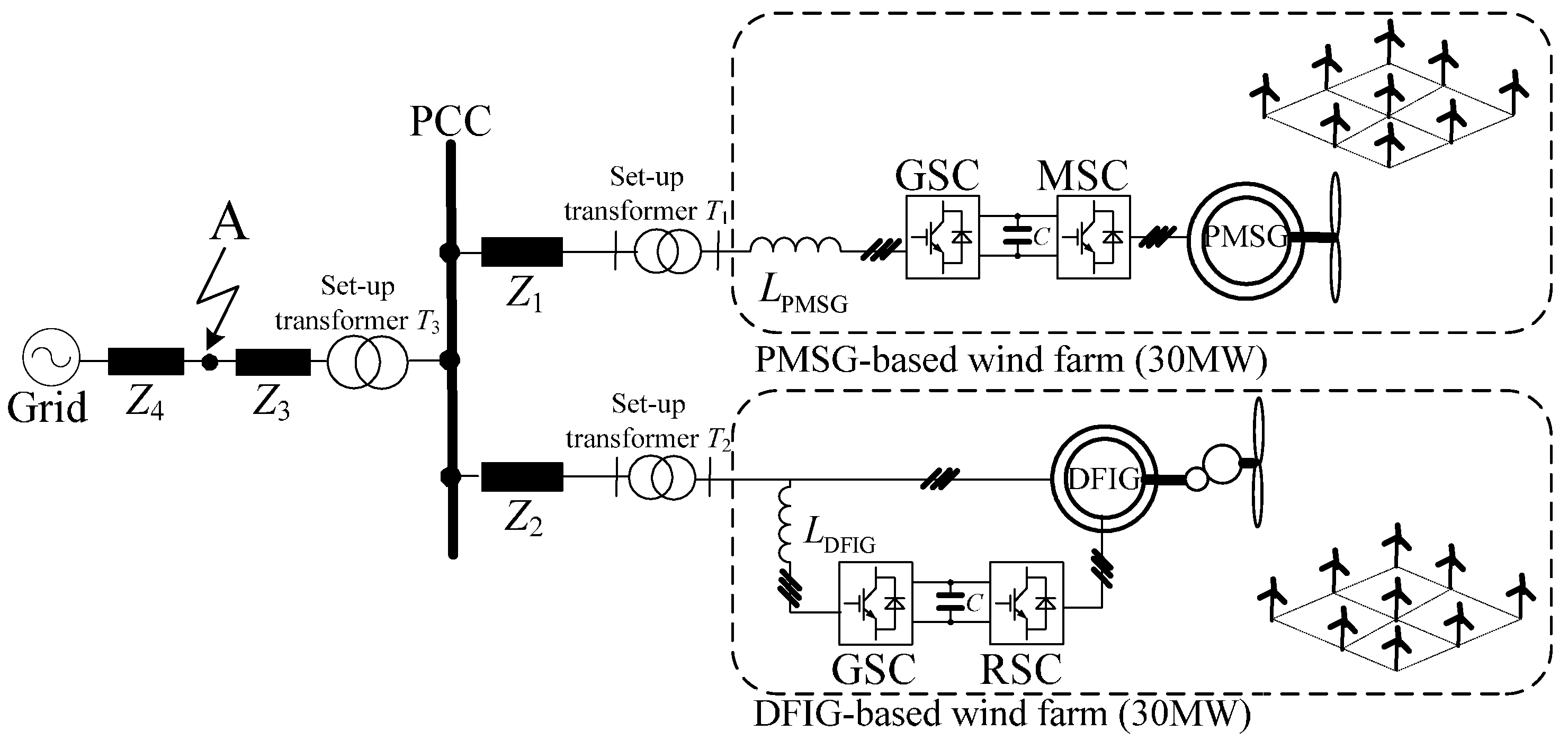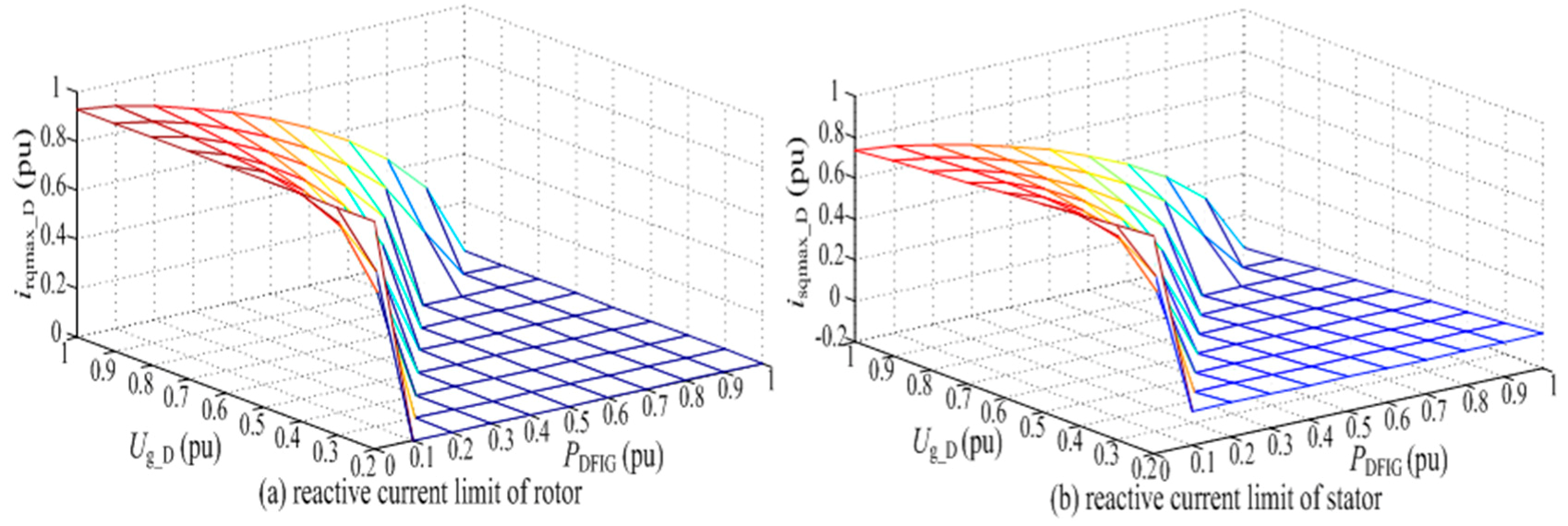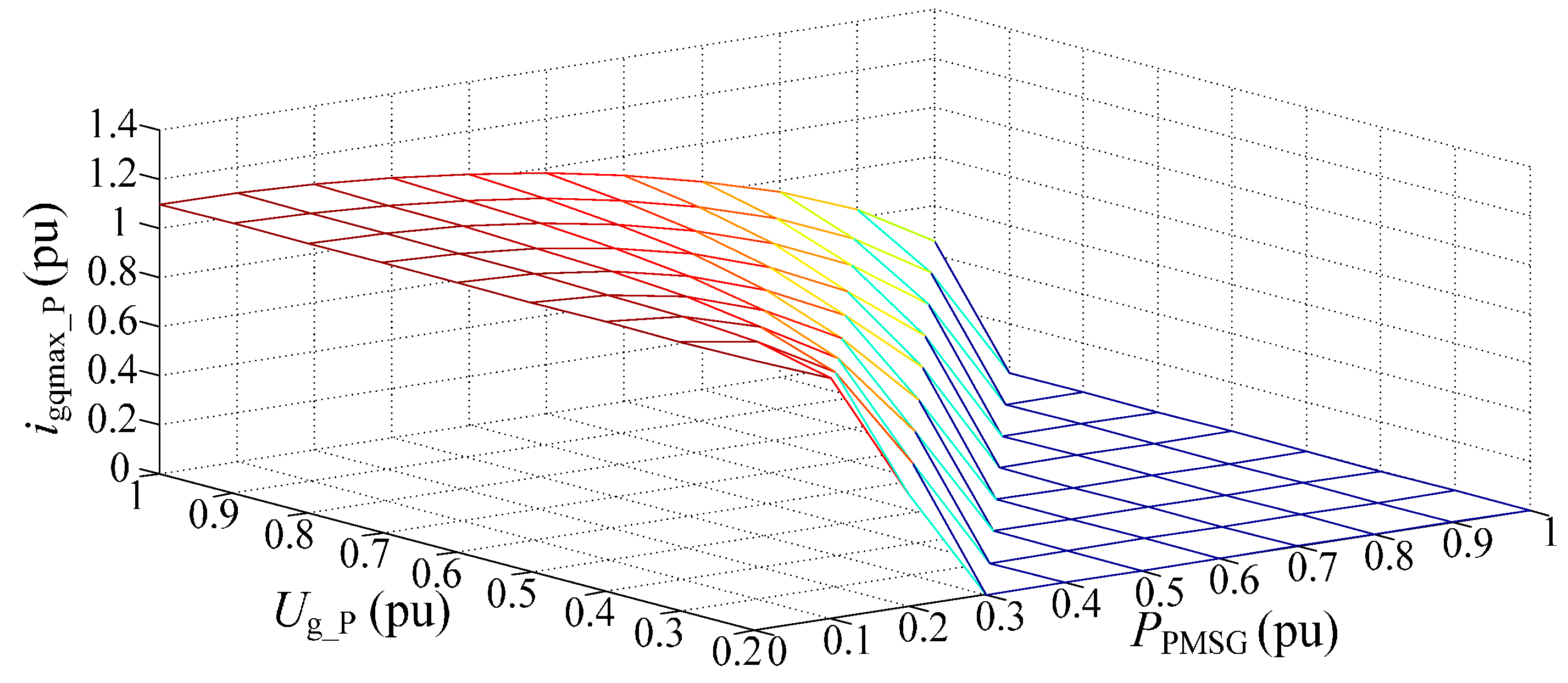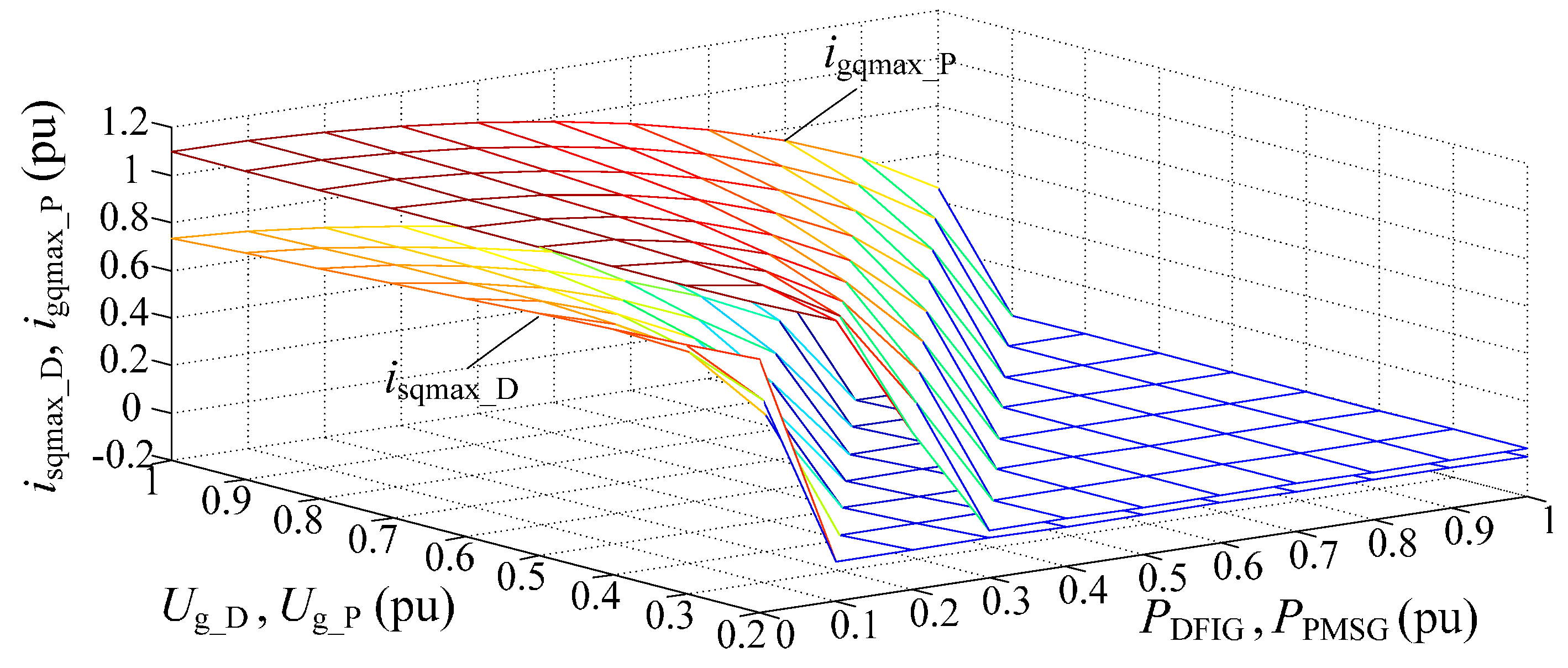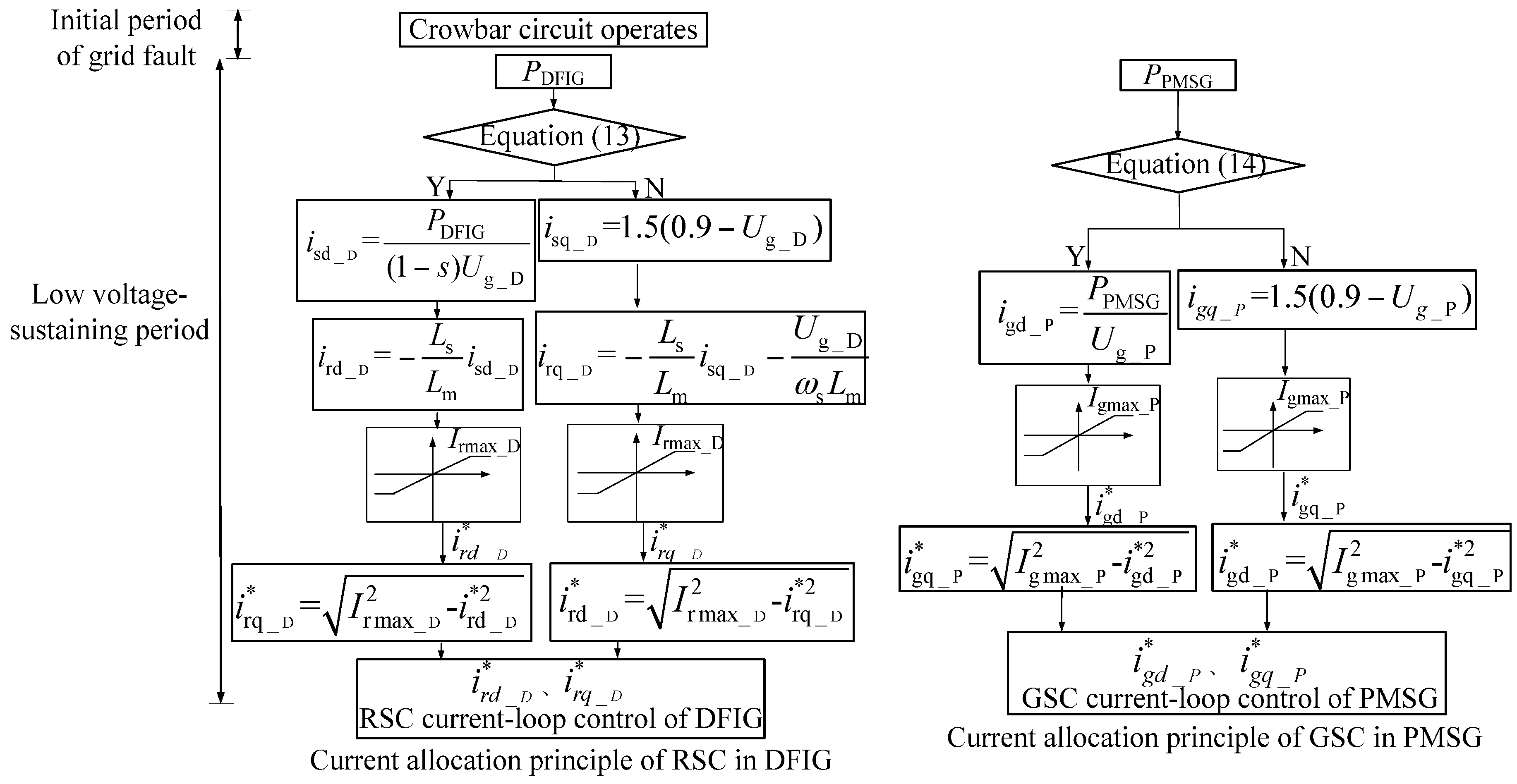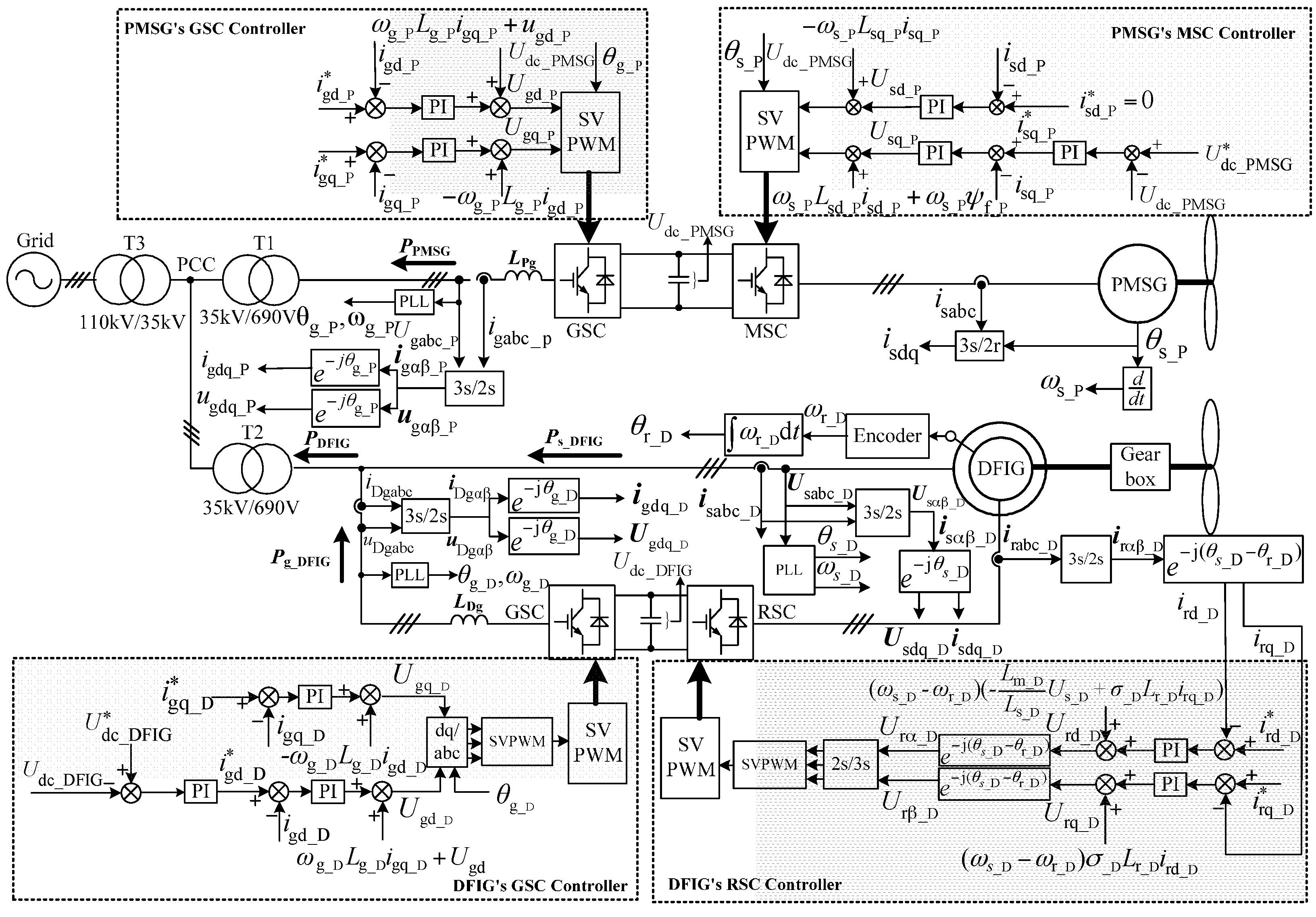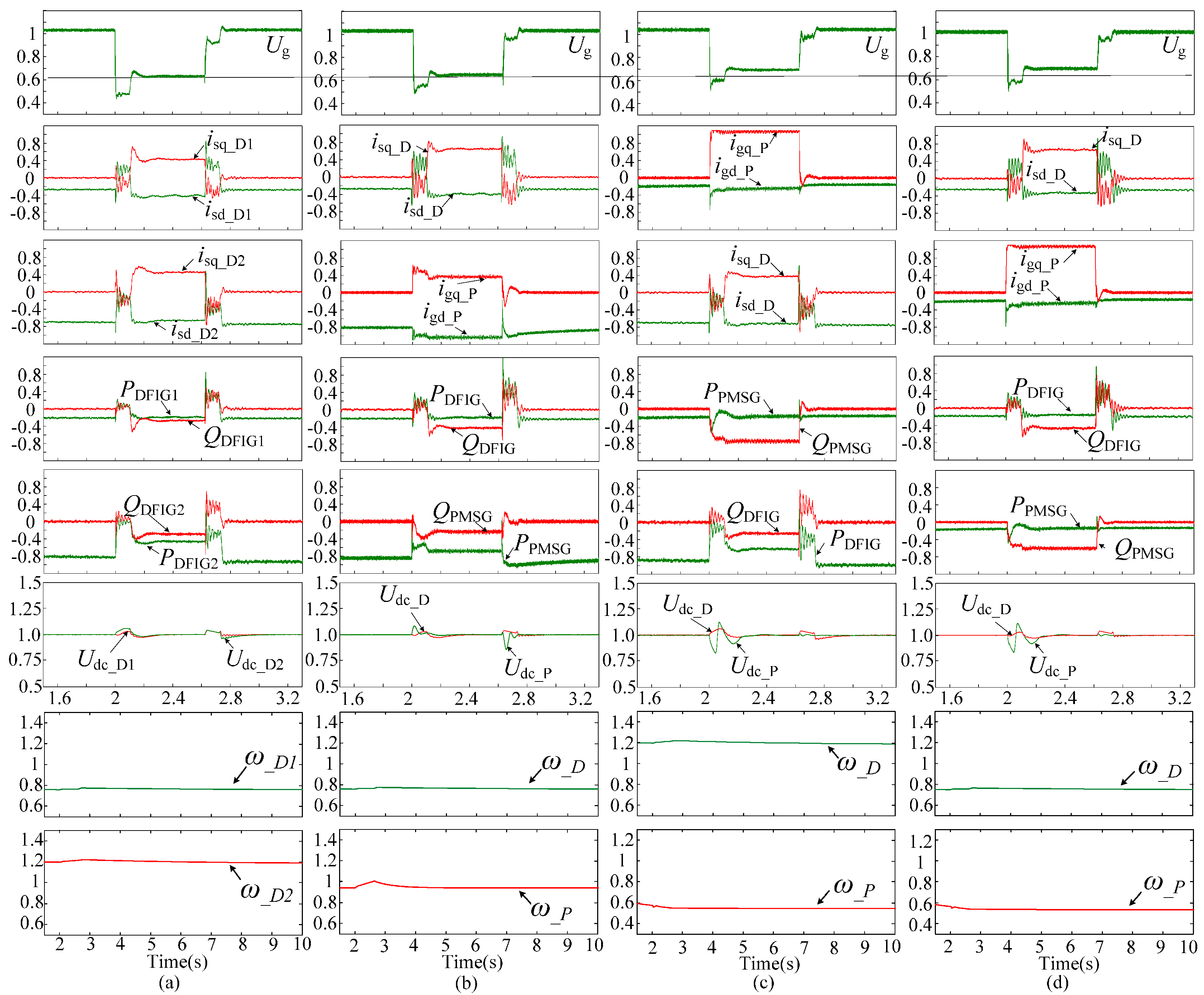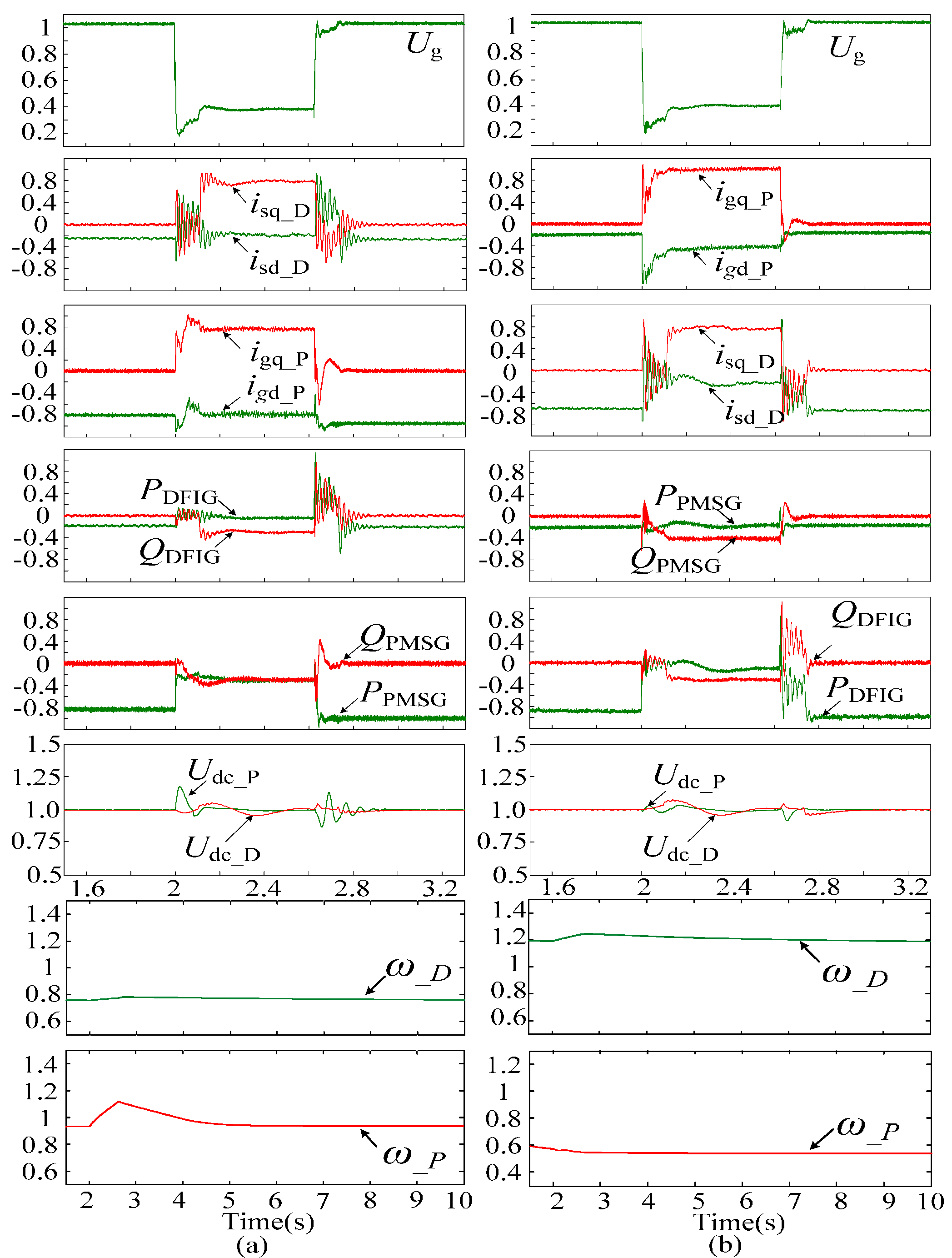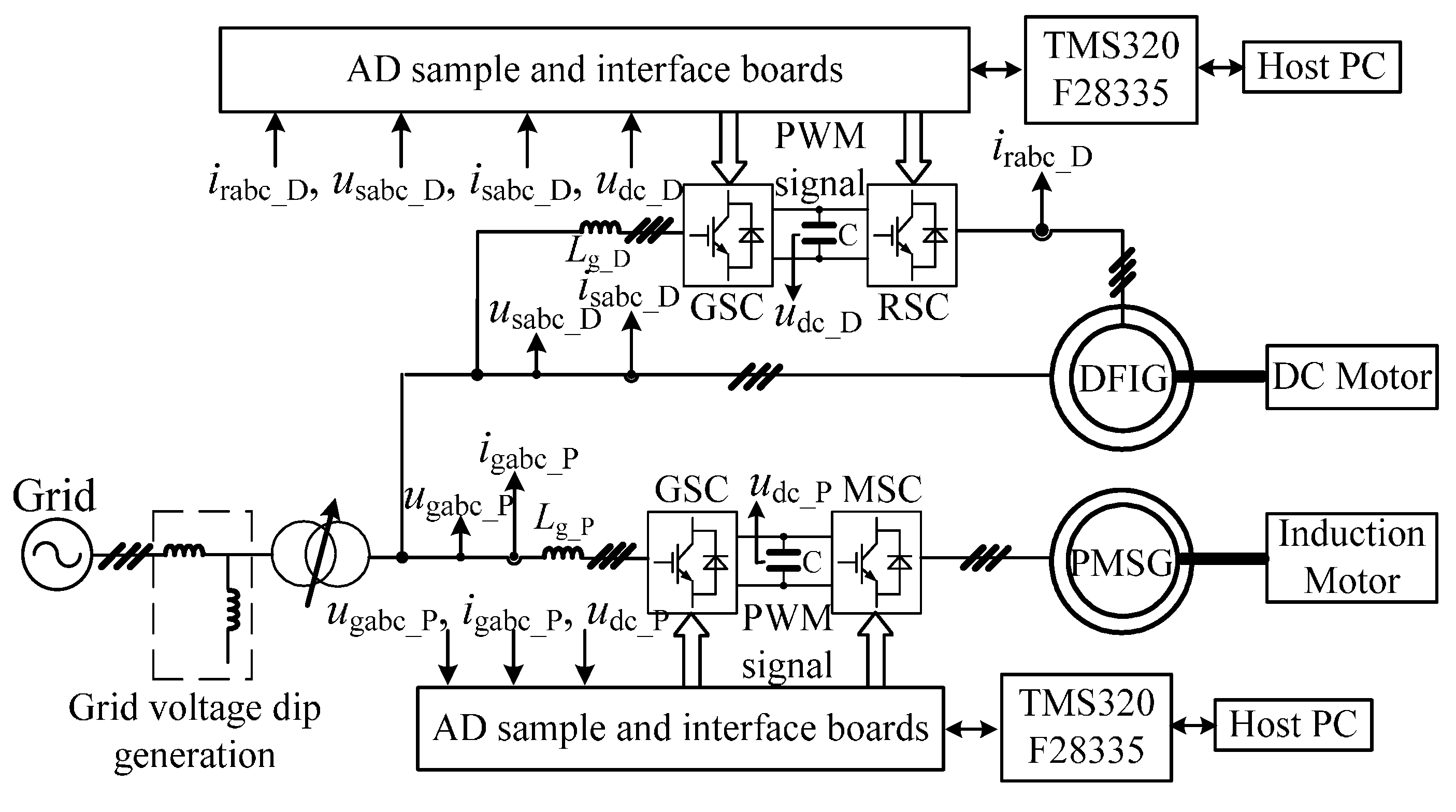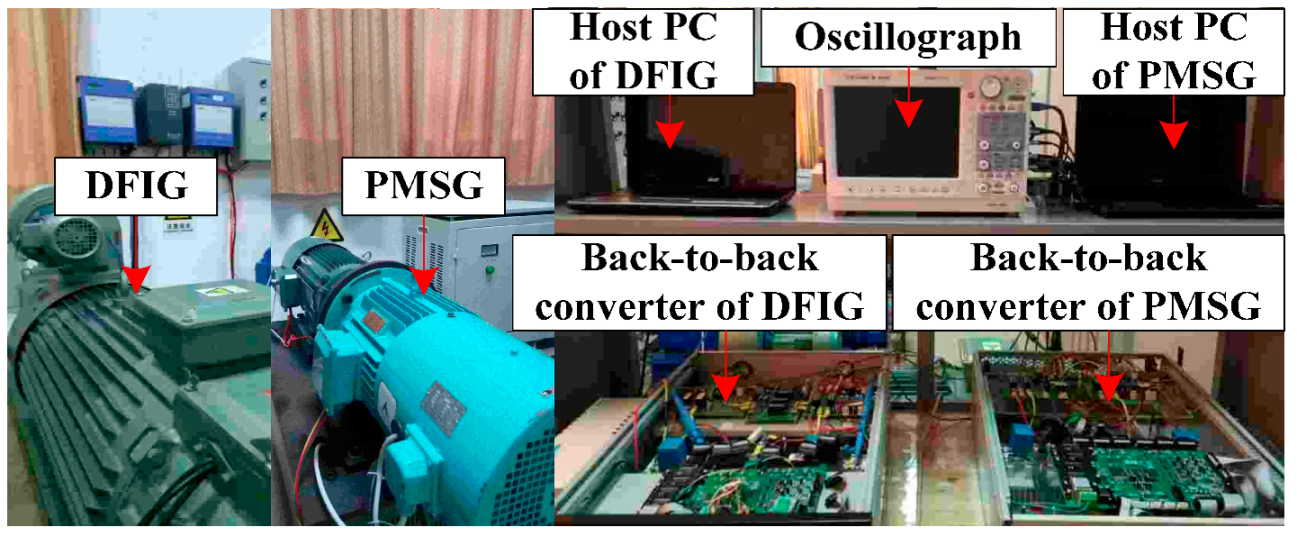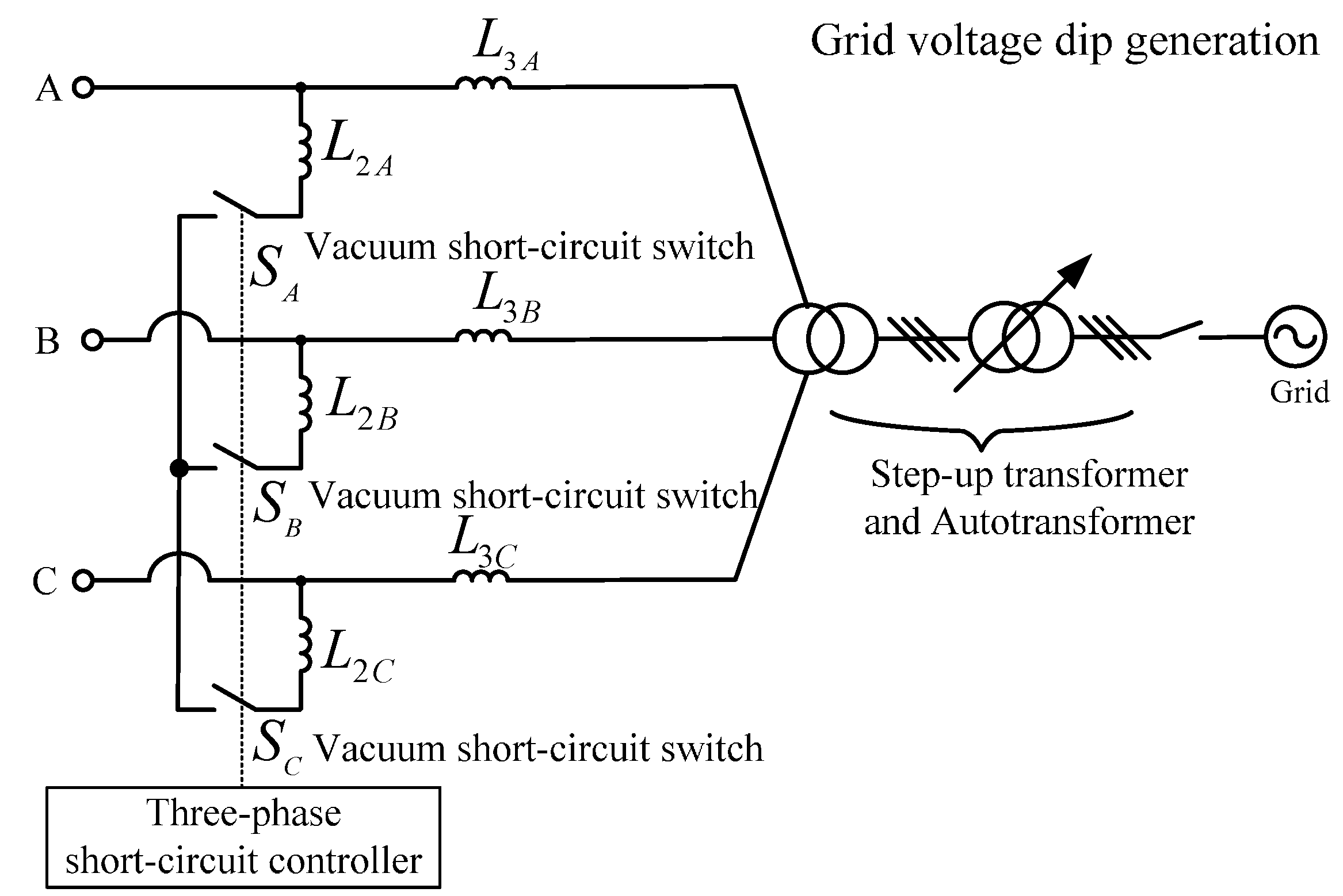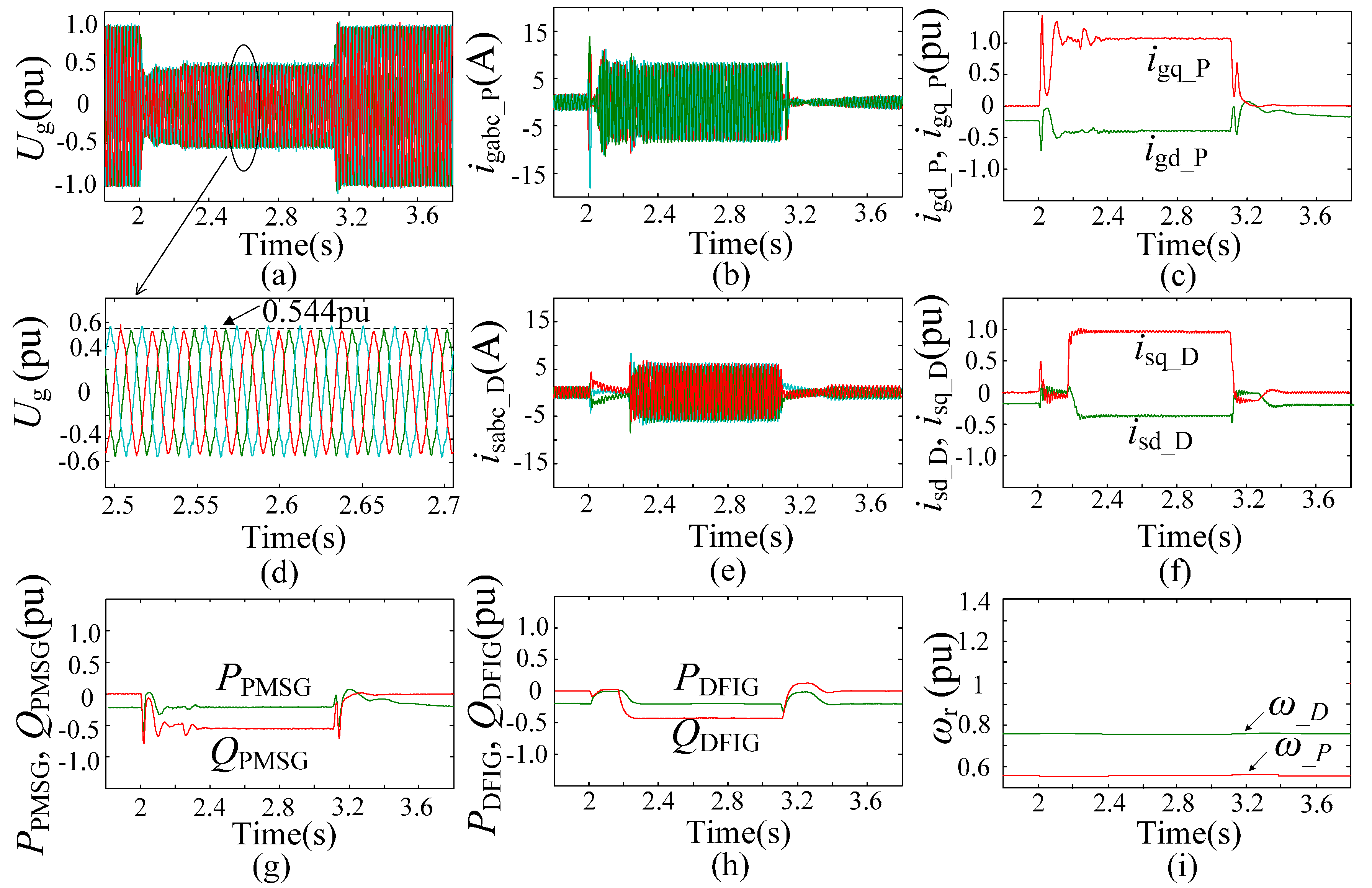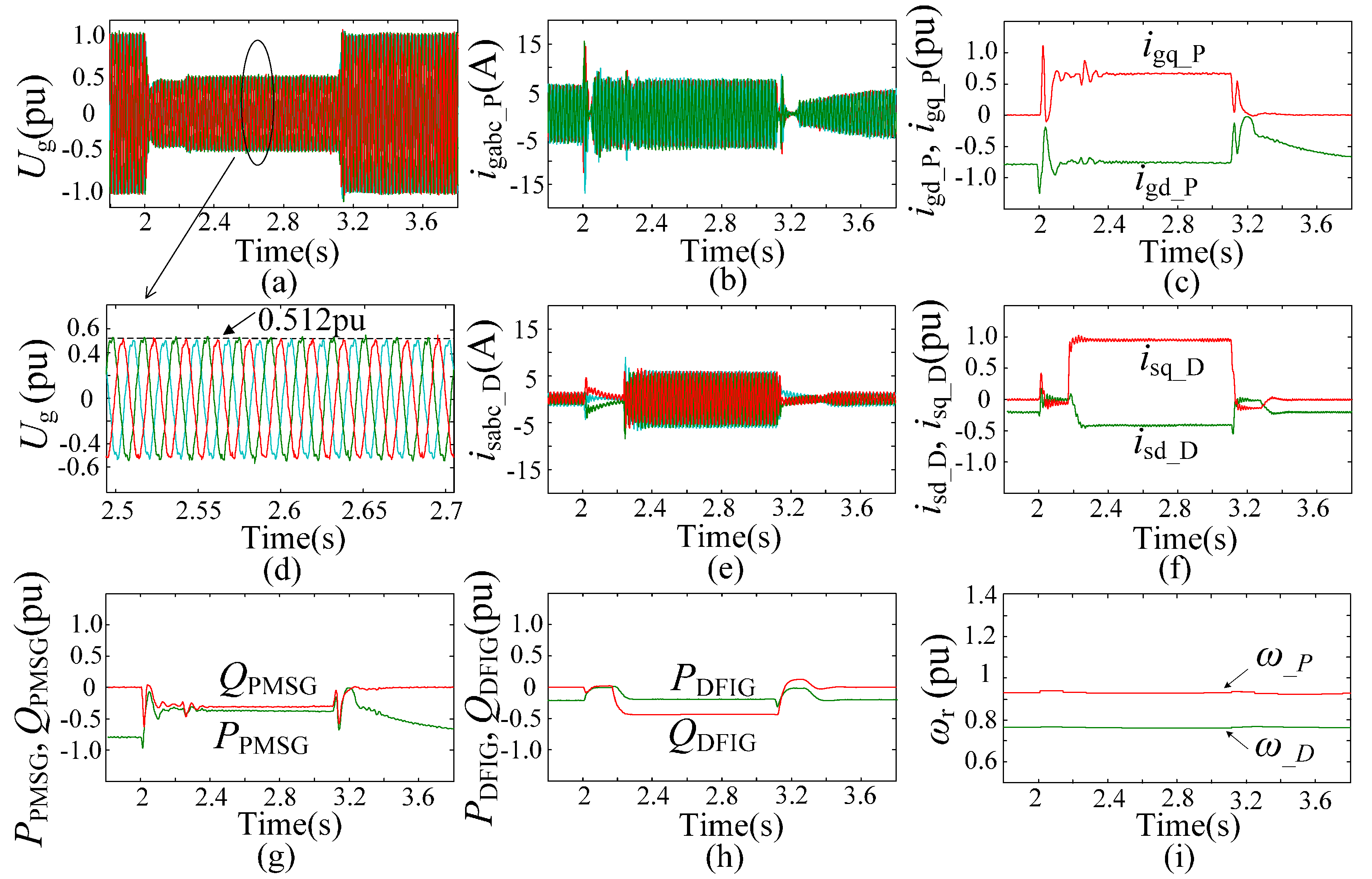1. Introduction
With wind energy penetration levels to the power systems rapidly increasing, the impacts of large-scale wind power generation systems on power grids have become much more significant than ever before [
1,
2]. As a consequence, grid-connected wind farms are required to be more reliable and to be able to withstand grid voltage disturbances. Nowadays, stringent low-voltage ride-through (LVRT) codes have been issued in many countries [
3,
4,
5]. In most of these codes, grid-integrated wind farms need to remain connected to the power grid for a certain period of time during grid faults. Moreover, it has become a need that wind power generation systems should also provide reactive power support to help the grid voltage recovery.
Variable speed-constant frequency (VSCF) wind turbines using doubly fed induction generators (DFIG) or permanent magnetic synchronous generators (PMSG) have been most widely used in newly-installed wind farms [
6,
7,
8,
9]. Hybrid wind farms consisting of traditional fixed speed induction generators (FSIG)-, DFIG- and/or PMSG-based wind turbines have been the trend for expanding the existing wind farms and constructing large-scale new wind farms when considering the installed capacity of wind farms, construction cost, grid codes, etc. [
10,
11,
12,
13,
14]. Compared with wind farms containing only one type wind turbines, operators of grid-connected hybrid wind farms can take advantage of the operation characteristics of different types of wind turbines and realize a modified control to further improve the operation performance and stability of the whole farm. Furthermore, it is obvious that hybrid wind farms with DFIG- and PMSG-based wind power generation systems may have more flexible controllability than any other types of hybrid wind farms because of the advantages of the VSCF wind turbines, which can provide a better performance, even under abnormal power grid conditions. For instance, in Jiangsu Province (China), the Rudong 150 MW hybrid offshore wind farm built in 2013 consists of both DFIGs and PMSGs.
Studies have been carried out on the operation performance and control methods of hybrid wind farms with different types of wind turbines. Coordinated control strategies were proposed in [
10,
11] for hybrid wind farms with DFIG- and FSIG-based wind power generation systems during symmetrical grid faults. With those proposed control strategies [
10,
11], the voltage at the point of common coupling (PCC) in such a hybrid wind farm can be effectively supported by controlling the DFIG-based wind turbines to provide reactive power to the power grid, which improves the LVRT capability of the whole wind farm. In [
12], a hybrid wind farm consisting of FSIG- and PMSG-based wind turbines was studied, and a LVRT control strategy was proposed by controlling the PMSG-based wind turbines to provide the required reactive current of the FSIG-based sub-wind farm during grid voltage dips. Nevertheless, extra hardware devices must to be installed for the intercommunication between the two types of wind power generation systems to implement the proposed control strategy [
12]. Aiming at a hybrid wind farm with DFIG- and PMSG-based wind turbines, small-signal stability characteristics and low frequency power oscillation control strategy were investigated in [
13,
14]. It is reported that well-regulated VAR compensation equipment can effectively improve the stability of integrated wind energy conversion systems [
13,
14].
For the LVRT control method of hybrid wind farms, although the proposed control strategies in [
10,
11] can effectively improve the operation performance of the hybrid wind farm consisting of FSIG- with DFIG- or PMSG-based wind turbines under grid faults, there are still some drawbacks in the strategies. For instance, the reactive power support capability from DFIG or PMSG system was not fully utilized in those studies. Furthermore, the active power output of DFIG or PMSG system was not discussed in the proposed control strategy. If the reduction in the active power output from the wind farm is significant, the active power imbalance and the generator over-speed issues may occur, which will weaken the stability of the grid-connected wind farm and the connected power grid. In addition, additional hardware devices will undoubtedly increase the cost of the whole system.
As stated above, the potential of hybrid wind farms consisting of DFIG- and PMSG-based wind turbines can be better utilized to further improve the LVRT capability without utilizing any additional hardware devices, however, little research work has been done on this topic in previous studies.
DFIG- and PMSG-based wind turbines have some common advantages, namely maximum power point tracking (MPPT), VSCF operation, and decoupled control of active and reactive power. Nevertheless, each of them also has its unique features. Regarding to a DFIG, it can operate under a wide wind speed range while using converters rated for only 20–35% of the rated power. However, because the stator of a DFIG is directly connected to the electrical grid, it is extremely sensitive to grid voltage disturbances [
15,
16,
17]. Different from DFIG-based wind turbines, utilizing full-rated converters which are connected between the generators and the power grid, PMSG systems have the advantages such as high power density, high grid voltage fault controllability, and simple control method, except high initial installation costs [
18,
19,
20]. On the other hand, considering the geographical distribution characteristics of large-scale wind farms and the uncertainty of wind speed, the wind energy captured by the wind turbines in the same wind farm can be different [
21]. It is unlikely that all the wind turbines in a wind farm are under full-load operation condition at the same time. The partially loaded wind turbines can be made full use of to provide more flexible reactive power support to the power grid. Hence, if the operation characteristics of DFIG- and PMSG-based wind turbines and the temporal-spatial distribution characteristics of a large-scale hybrid wind farm are comprehensively taken into account, a modified LVRT control strategy for the hybrid wind farm with DFIG and PMSG can be developed to improve the transient voltage performance when a severe grid fault occurs.
In this paper, a hybrid wind farm which consists of a DFIG-based sub-wind farm and a PMSG-based sub-wind farm is considered as the system for investigation. The main objectives of this paper include: (1) Deduction of the reactive current upper limit expressions for DFIG- and PMSG-based sub- wind farms; (2) Derivation of the feasible regions of the DFIG- and PMSG-based sub-wind farms for LVRT control during symmetrical grid faults, which is based on the corresponding sub-wind farm active power outputs and the terminal voltage dip depths; (3) Development of an improved current allocation method and a coordinated LVRT control strategy for the hybrid wind farm, which can control the two sub-wind farms to autonomously provide the corresponding maximum reactive power supports; and reduce the drop of the corresponding active power outputs without utilizing any additional communication hardware devices.
The remainder of the paper is organized as follows: the hybrid wind power generation system under study is introduced in
Section 2.
Section 3 presents the deduction of the reactive current upper limit expressions of the two sub-wind farms under different operation conditions. The proposed coordinated LVRT control strategy is given in
Section 4. The proposed control strategy is verified by the simulation and experimental, which are given in
Section 5 and
Section 6, respectively. The conclusions are drawn in
Section 7.
4. Coordinated LVRT Control Strategy for the Hybrid Wind Farm under Symmetrical Grid Faults
In order to improve the stability and reliability of grid-connected wind farms, strict LVRT requirements have been implemented worldwide. For instance, the “Technical rule for connecting wind farm to power system” issued in China (GB/T 19963-2011) [
26] requires that appropriate reactive currents
IQ need to be provided by grid-connected wind farms under symmetrical grid faults; and the per-unit value of
IQ must conform to:
where
UT and
IN are the per-unit values of terminal voltage of a grid-connected wind farm and the rated current of the wind farm, respectively.
It is indicated in Equation (11) that the required minimum reactive current injected by a wind farm under symmetrical grid faults should be 1.5(0.9 −
UT)
IN, and more reactive current can further help maintain voltage level during transients. However, as discussed in
Section 3, a wind power generation system may not be able to supply the required minimum reactive current under some conditions such as the wind farm working under high power generation condition or the terminal voltage of the wind farm being at a lower value region. It is beneficial to find the operation conditions in which the wind farm can provide the required reactive current, which can be used to devise control methods in symmetrical grid fault situations. Those operation conditions are defined as the feasible region of a wind farm.
According to Equations (7), (10) and (11), to meet the LVRT requirements, the corresponding reactive current limits of the DFIG stator and the GSC in the PMSG system need to be:
Based on the parameters in
Table A3 and
Table A4 in
Appendix A, the feasible regions of the DFIG-and the PMSG-based sub-wind farms can be derived as:
Figure 5 presents the feasible regions of the DFIG- and PMSG-based sub-wind farms under symmetrical grid faults. When the DFIG- or PMSG-based sub-wind farm operates within its feasible region as the shaded area in
Figure 5, the active power output is less than the corresponding critical active power with the certain terminal voltage. This indicates that the reactive current limit of the sub-wind farm is larger than the required minimum value of the LVRT requirement. In other words, under this scenario, the sub-wind farm is capable of providing the required reactive current, while the active power output of the sub-wind farm can still be the same as that under normal condition. On the contrary, when the active power output of the DFIG- or the PMSG-based sub-wind farm is more than its corresponding critical active power during a symmetrical grid fault, the wind turbines will stray from their feasible regions. In this case, the reactive current capacity of the wind system does not meet the LVRT requirement. To deal with this problem, the sub-wind farm has to be controlled to reduce the active power output and to supply the required minimum reactive current to support the grid voltage.
Based on the analysis above, a coordinated LVRT control strategy for the hybrid wind farm with DFIG- and PMSG-based wind turbines is proposed in this paper. Without any additional communication hardware devices, the DFIG- and PMSG-based wind turbines are individually controlled to deliver the respective maximum reactive currents to the power grid. Meanwhile, the variation of the corresponding active power outputs of the two sub-wind farms can be reduced during the symmetrical faults. The current allocation principles of the RSC in the DFIG system and the GSC in the PMSG system are shown in
Figure 6.
In the first period after a grid fault occurs, due to the significant voltage sag, the transient component will be appeared in the stator flux, which can cause the over voltage and over current of the rotor circuit. When the amplitude of the over current exceeds the protecting threshold, the active crowbar is triggered to short the rotor circuit of the DFIG, which can accelerate the decay of transient stator flux to avoid over current of the RSC. When the DFIG stator transient flux is almost eliminated, the machine enters the stable short circuit stage and the crowbar is tripped off. The RSC in the DFIG then recovers back to the normal control to provide the transient support to the power grid.
During the low voltage-sustaining period, the voltages at both terminals of DFIG-and PMSG-based sub-wind farms (
Ug_D and
Ug_P) and the active power outputs (
PDFIG and
PPMSG) are measured in real time at the corresponding local sites. Then, the measured values of
Ug_D,
Ug_P,
PDFIG, and
PPMSG are utilized to judge whether the DFIG- or PMSG-based sub-wind farm is under the corresponding feasible region, as described in Equation (12) and
Figure 5. According to the actual situation, one of the following two strategies is applied to control the hybrid wind farm:
The DFIG- or the PMSG-based sub-wind farm is under its corresponding feasible region. In this case, the reference value of the active current need to be set as that under normal condition, for ensuring the constant active power output before and after the grid faults. In the meantime, the reference value of the reactive current is set as the limit value as given in Equations (7) or (10) to supply the maximum reactive power to the power grid.
The DFIG- or PMSG-based sub-wind farm is out of its corresponding feasible region. Under this scenario, the reference value of the reactive current is firstly set as the required minimum reactive current of LVRT requirements to meet the grid-connected wind farm code. Considering the allowable maximum current of the DFIG stator or the GSC in the PMSG system, more room can be given to the active current to decrease the curtailment of the active power output of the whole wind farm before and after grid faults.
It is worth stating that the PMSG-based sub-wind farm can immediately employ the low voltage-sustaining strategy when the grid fault occurs, without the operation (crowbar kicked in and tripped off) during the initial period of grid fault like DFIG-based sub-wind farm, owing to the full-scale back-to-back converter configuration.
Figure 7 shows the schematic diagram of the proposed coordinated control scheme for the hybrid wind farms under symmetrical fault. The control targets of the GSC in the DFIG and MSC in the PMSG system are still to remain DC-link voltage stable. Moreover, the control targets of the RSC in the DFIG and the GSC in the PMSG system are to achieve the decoupling control of active power and reactive power. By adopting the proposed current allocating principle, the active and reactive current reference values in the DFIG- and the PMSG-based sub-wind farms can be set independently. According to the current reference values, the converters in the wind farm are regulated via appropriate controllers such as PI controllers, and then the operation performance of the hybrid wind farm can be significantly improved during grid faults. On one hand, the maximum reactive current can be supplied by the wind farm, which helps the recovery of the grid voltage. On the other hand, the curtailment of the active power output of the hybrid wind farm can be reduced, which improves the stability of the grid-connected wind farm and provides the transient active power support to the power grid.
5. Simulation Studies
In order to verify the effectiveness of the proposed LVRT control scheme under symmetrical grid faults, simulations on a hybrid wind farm, as shown in
Figure 1, have been conducted by using MATLAB/Simulink. The simulation models of the DFIG and PMSG are based on the motor convention. Details of the studied system are given in
Appendix A.
During the simulation, the voltage at point A drops to 50% of the rated voltage (0.5 pu). For comparison, the simulation on a 60 MW DFIG-based wind farm is also conducted, which just provides the required minimum reactive current as Equation (11) for the power grid under symmetrical grid faults.
Figure 8a presents the LVRT performance of the 60 MW DFIG-based wind farm, in which half of the DFIGs output 0.2 pu active power (in the low wind speed region), and the others supply 0.8 pu active power (in the high wind speed region) before the symmetrical grid fault occurs. During the first period of the grid fault (2~2.1 s), the active crowbars in DFIG systems are triggered, and the extra reactive current is absorbed from the power grid for excitation of DFIG, which leads to the voltage at PCC (
Ug) further dropping to 0.48 from 0.5 pu. At the same time, there is an elevation in DC link voltages (
Udc_D1 and
Udc_D2) and the rotor rotational speed (
ω_D1 and
ω_D2) begins to increase. During the second period of the symmetrical grid fault (2.1~2.625 s), with the stable DC link voltage, both of the two DFIG-based sub-wind farms inject 0.421 pu reactive current (
isq_D1 and
isq_D2) and 0.263 pu reactive power (
QDFIG1 and
QDFIG2) to the power grid. Correspondingly the voltage at PCC is elevated to 0.625 from 0.48 pu. However, the stator current of the DFIG system with low wind speed (
isd_D1) is much less than the allowable maximum current value, which indicates that more reactive current could be output for further supporting the grid voltage. In addition, the rotor rotational speed (
ω_D1 and
ω_D2) gradually return to the stable operation state value when the symmetrical fault is cleared.
With the proposed LVRT control strategy, the simulation results of the hybrid wind farm consisting of 30 MW DFIG-based sub-wind farm and 30 MW PMSG-based sub-wind farm under 0.5 pu grid voltage dip depth are presented in
Figure 8b–d.
Before the symmetrical grid fault occurs, 0.2 pu active power and 0.8 pu active power are output by the DFIG- and PMSG-based sub-wind farms, respectively, and the corresponding simulation results are shown in
Figure 8b. Under this scenario, the DFIG-based sub-farm is within its feasible region. Consequently, the output reactive current of the DFIG system (
isq_D) increases to 0.652 pu according to the corresponding reactive current limit, meanwhile, the output reactive power (
QDFIG) increases to 0.422 pu and the active power (
PDFIG) is maintained at 0.2 pu. On the contrary, according to
Figure 5b, the PMSG-based sub-wind farm is out of its feasible region because of the active current at large value region. As a result, the PMSG system only supplies 0.374 pu reactive current (
igq_P) and 0.244 pu reactive power (
QPMSG) to preliminarily meet the requirements in the grid code, while the output active power (
PPMSG) decreases to 0.461 pu. Under such condition, the voltage at PCC is elevated to 0.648 from 0.5 pu, and the total reactive current of the hybrid wind farm increases to 1.026 from 0.842 pu, which is 19.12% larger than that of the 60 MW DFIG-based wind farm in scenario (a). Similarly, the total output reactive power increases to 0.661 from 0.526 pu, which is 26.72% more than that of the 60 MW DFIG-based wind farm. Meanwhile, the total output active power also increases to 0.89 from 0.731 pu, which is 21.92% larger than that of the 60 MW DFIG-based wind farm in scenario (a). The analysis indicates that the hybrid wind farm with DFIG and PMSG achieves a superior operation performance over the wind farm only containing DFIG.
Figure 8c presents the simulation results of the hybrid wind farm, in which the DFIG-based sub- wind farm outputs 0.8 pu active power and the PMSG-based sub-wind farm outputs 0.2 pu active power before the symmetrical grid fault occurs. Compared to the DFIG system with the same active power output, the PMSG system has a larger reactive current limit, as shown in
Figure 4. Therefore, under this condition, the total reactive current of the hybrid wind farm increases to 1.411 from 0.842 pu, which is 67.58% more than that of the 60 MW DFIG-based wind farm in scenario (a). Similarly, the output reactive power increases to 0.983 pu, and it is 86.88% more than that of the 60 MW DFIG-based wind farm in scenario (a). As a result, the voltage at PCC is elevated to 0.693 from 0. 5 pu.
When both of the DFIG- and PMSG-based sub-wind farms output 0.2 pu active power, the two sub-wind farms are both within their corresponding feasible regions. As a consequence, the whole system can provide more reactive to support the power grid, and avoid the generator over-speed issues. The corresponding simulation results are shown in
Figure 8d. As can be seen from
Figure 8d, the total output reactive current and reactive power increase to 1.743 from 0.842 pu and 1.227 from 0.526 pu, respectively. As a result, the voltage at PCC is significantly elevated to 0.702 from 0.5 pu, which indicates that the transient grid voltage level and the LVRT capability of the hybrid wind farm are both significantly improved.
When the voltage at point A severely dips to 0.2 pu, the LVRT performance of the hybrid wind farm with the proposed control strategy is given in
Figure 9.
Figure 9a shows the simulation results, in which the DFIG- and PMSG-based sub-wind farms output 0.2 pu active power and 0.8 pu active power respectively, before the symmetrical grid fault occurs. Under this condition, both of the two sub-wind farms are out of their corresponding feasible region. As a consequence, they are controlled to reduce the output active power and preferentially supply the required minimum reactive current to meet the grid code, which elevates the voltage at PCC to 0.382 from 0.2 pu.
Before the severe symmetrical grid fault occurs, the DFIG- and PMSG-based sub-wind farm are controlled to output 0.8 pu active power and 0.2 pu active power, respectively.
Figure 9b shows the simulation results of the hybrid wind farm. Compared with
Figure 9a, because the PMSG system can supply more reactive current, the total reactive current and reactive power output by the hybrid wind farm are much more under this operation condition. Consequently, the voltage at PCC is obviously elevated to 0.408 from 0.2 pu.
With different grid voltage dip depths, the values of the voltage at the PCC under different operation conditions are listed in
Table 1. It can be seen that, compared with the 60 MW DFIG-based wind farm with traditional control strategy, the LVRT performance of the hybrid wind farm with the proposed control strategy can be further improved. On the one hand, the transient grid voltage level can be effectively enhanced, because of more reactive current and reactive power provided by the hybrid wind farm. On the other hand, the proposed LVRT control strategy can help the hybrid wind farm to output the active power as much as possible under symmetrical grid faults, which helps avoid generator over-speed issues and provides transient active power support to the power grid.
6. Experimental Results
The experimental hybrid generators-based wind energy conversion system consisting of a DFIG and a PMSG, which are both based on the motor convention, has been built in the lab for verifying the effectiveness of the proposed coordinated LVRT control scheme. The schematic diagram and the setup of the experimental system are shown in
Figure 10 and
Figure 11, respectively, and the detailed parameters of the test system are given in
Appendix B.
As shown in
Figure 10 and
Figure 11, the DFIG and the PMSG are driven respectively by a DC motor and an induction motor, which are both operated by using the constant speed control. Therefore, the rotor speed of the DFIG and PMSG basically will not change during the faults. Furthermore, the grid voltage sag is generated using three air core reactors (
L2A/
L2B/
L2C) and three-phase short-circuit switches, as shown in
Figure 12. Initially, the three-phase vacuum short-circuit switches (S
A/S
B/S
C) are disconnected, and the experimental hybrid wind power generation test bench is directly connected to the power grid through the series inductor. At the 2.0 s, the three-phase vacuum short-circuit switches are closed and the simulated symmetrical fault occurs, the grid voltage at PCC dips to 0.45 pu. At the 3.1 s, the vacuum short-circuit switches are disconnected and the symmetrical fault is cleared, the grid voltage recovers back to 1.0 pu. For the DFIG system, the crowbar is triggered at 2 s and disabled at 2.2 s when the LVRT control strategy is applied. At 3.1 s, the crowbar is triggered again and stays operating until 3.3 s. Different from the DFIG system, the LVRT control strategy is employed at 2 s and disabled at 3.1 s in the PMSG system.
In order to highlight the advantages of the proposed coordinated LVRT control strategy, the experiment for the hybrid wind power system with the traditional LVRT control strategy which just provides the required minimum reactive current is also conducted for comparison. Before the symmetrical grid fault occurs, the active power outputs of the PMSG and the DFIG are both set at 0.2 pu for simulating the low wind speed operation condition. The experimental results are shown in
Figure 13.
As seen from
Figure 13c,f–h, with the conventional LVRT control strategy, the reactive currents provided by the PMSG and the DFIG (
igq_P and
isq_D) are both 0.675 pu, which is equal to the required minimum value as Equation (11). Meanwhile, the reactive power outputs from the DFIG and the PMSG (
QDFIG and
QPMSG) are both 0.34 pu. In addition, because both the DFIG and the PMSG operate within the corresponding feasible regions under such condition, the active currents of the two systems (
igd_P and
isd_D) are at low value regions, even during the grid fault. Hence, the active power outputs (
PDFIG and
PPMSG) can still be 0.2 pu. The voltage at PCC (
Ug) is elevated from 0.45 to 0.5 pu as shown in
Figure 13a. However, the currents of both the GSC in the PMSG and the DFIG stator are much less than the respective allowable maximum values, as shown in
Figure 13b,e. This indicates that more reactive current can be supplied to the power grid for further elevating the voltage at PCC in such symmetrical grid fault situation.
Figure 14 shows the experimental results with the proposed coordinated LVRT control strategy when 0.2 pu active power is being delivered from both the DFIG and the PMSG systems. Under this condition, the DFIG and the PMSG are both within their corresponding feasible regions. Hence, the currents of the GSC in the PMSG system and the DFIG stator (
igabc_P and
isabc_D) can be made full use of to improve the operation performance of the hybrid generation system during grid faults, as shown in
Figure 14b,e. As shown in
Figure 14c,f–h, 1.07 and 0.97 pu reactive currents (
igq_P and
isq_D) which are equal to the corresponding upper limit values can be injected by the PMSG and the DFIG systems, respectively. As a result, the maximum reactive power (
QPMSG and
QDFIG) can be generated from the hybrid generation system. Meanwhile, the active power outputs of the two systems (
PPMSG and
PDFIG) are still 0.2 pu without changing before and after grid faults. Compared with
Figure 13a, the voltage at PCC (
Ug) can be significantly elevated from 0.45 to 0.544 pu with the proposed control strategy, as seen from
Figure 14a.
To further verify the effectiveness of the proposed coordinated LVRT control strategy, the experiment is conducted with 0.2 pu active power output from the DFIG and 0.8 pu active power output from the PMSG, which simulates the high wind speed operation condition, as shown in
Figure 15. During the grid fault, the DFIG system is within its feasible region. Consequently, 0.95 pu reactive current (
isq_D) and 0.49 pu reactive power (
QDFIG) can be provided by the DFIG system according to the reactive current limit. Meanwhile, the active power output from the DFIG system (
PDFIG) can be controlled constant, as shown in
Figure 15e,f,h. On the contrary, the PMSG system is out of its feasible region, thus, the injected reactive current (
igq_P) is still 0.675 pu, and the reactive power output (
QPMSG) is only 0.35 pu. As the active current of the PMSG system is limited according to the allowable maximum current of the GSC, the active power output from the PMSG (
PPMSG) is less than that under normal operation condition, as shown in
Figure 15b,c,g. Compared with
Figure 14a, the voltage at PCC (
Ug) is increased from 0.45 to 0.512 pu, owing to the less reactive current delivered from the PMSG system, as seen from
Figure 15a.
Similarly,
Figure 16 shows the experimental results with 0.2 pu active power output from the PMSG and 0.8 pu active power output from the DFIG. In this situation, the DFIG is out of its feasible region while the PMSG is in. Thus, as seen from
Figure 16c,f–h, the active power output from the PMSG (
PPMSG) is still 0.2 pu, but the value (
PDFIG) is less than 0.8 pu for DFIG system during grid fault. In addition, 1.05 pu reactive current (
igq_P) and 0.55 pu reactive power (
QPMSG) can be generated by the PMSG system. However, only 0.675 pu reactive current (
isq_D) and 0.36 pu reactive power (
QDFIG) are injected to the grid by the DFIG system. Compared with
Figure 15a, the voltage at PCC (
Ug) is increased from 0.45 to 0.525 pu, owing to the reactive current capability of the PMSG system when it operates at a low active power value region, as shown in
Figure 16a.
